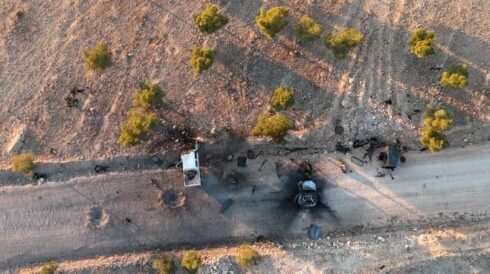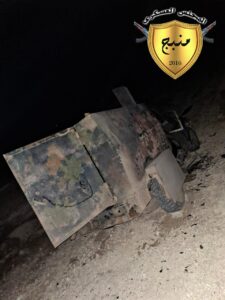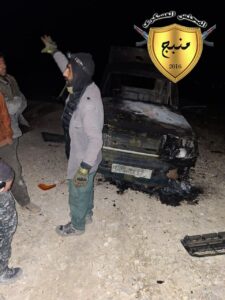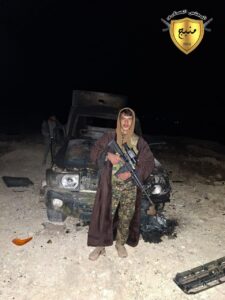More than one hundred fighters from the Turkish-backed Syrian National Army (SNA) and the Kurdish-led Syrian Democratic Forces (SDF) were killed in northern Syria over the last few days, the Syrian Observatory for Human Rights (SOHR) reported on January 5.
The clashes took place in the eastern Aleppo countryside, mainly close to the towns of Hajj Hussein, al-Sa’ideen, Atshana, Aloush, al-Mustaha, in addition to the Tishreen Dam and the Qara Qozak Bridge.
According to the London-based monitoring group, 50 SNA fighters and 12 others from the SDF were killed on January 3, which was the first day of the clashes.
On the second day, an additional 35 fighters of the SNA were killed by the SDF, including a commander from the so-called Sultan Murad Division. Four Kurdish fighters were also killed.
Turkish combat drones and fighter jets provided close air support to the SNA, launching several strikes against the SDF. Most of the group losses were caused by these strikes. Turkish-backed fighters failed to inflict any meaningful losses on the group, despite holding onto their positions.
From its side, the SDF continued to employ FPV suicide drones and other types of armed drones with much success. The targets were not limited to the SNA, as it also included military equipment of the Turkish military. Footage of the strikes were released.
While the intensity of the clashes have been going up, a large-scale Turkish offensive against the SDF in the eastern Aleppo countryside remains unlikely due to the United States continuous support of the group.
U.S. forces returned to the eastern Aleppo countryside right after the collapse of the Assad regime last month and while the Pentagon denied last week that it was establishing a base near the town of Kobani, a stronghold of the SDF, reinforcements continue to pour into the region.
On January 5, SOHR reported that a large U.S. military supply convoy made up of some 30 trucks headed to Kobani. U.S. warplanes were also spotted over the region.
Coinciding with the clashes in northern Syria, Israel resumed its strikes on the country, targeting bases of the now dissolved Syrian Arab Army.
A massive aerial attack targeted an ammunition depot and a military research facility near the town of Safirah in the southern Aleppo countryside on January 3.
The next day, a strike was reported near the coastal city of Latakia, although it was denied by Syrian authorities.
On January 5, another wave of strikes was reported near Damascus. Hebrew media reported that the target was underground military facilities.
These strikes -more than 490 according to the SOHR- are not only meant to destroy Syria’s remaining military capabilities, but also to pressure the country’s new ruler, the Islamist group Hay’at Tahrir al-Sham. Israel does not appear to be pleased by the terrorist-designated group.
Overall, the instability caused by foreign interventions in Syria, whether it is by Turkey, the U.S. or Israel, will create serious problems and could hinder the recovery process in the country.
MORE ON THE TOPIC:










they don’t care about us. we are all disposable to them. and in that they are egalitarian without prejudice although some favour buf only based on location location location
and really when you think about it outside of the propagandas boxes it’s a semitic genocide in the middle east and a russian in disguise under the” false flag “of ukraine not being russian . imo .cunning .foxy really the art of disingenuity .the great deceiver, ” and in the end times the whole world shall be deceived “
it’s been world wars and revolution against the goy whether the goy is west asian, arab, european, or eurasian — means little. they’re all under the boot of the grand architect of the masons, the hous of rothschild. even the catholic orders pay homage to the grand architect. he is the all father of the freemasons and satanists.
don’t use my name .grow up stop using everyone else’s names as well as dozens of your contrivance thanks.
annon is jens holms in reality.
and keep up prince edward runs the masons now since prince michael’s retired .stop publishing crap .
its the jews anon its the jews who are behind the war in syria the mossad and cia armed all the terrorists they want syria destroyed and divided the odet yinon plan israel wants to annex all land upto the euphrates and exterminate all people living there hts is a means to that end. their jewliani puppet enables them to get away with everything
mmmm, even the kids knows what are you commenting here friend. syria is no more, is the land of nobody’s, israel would benefit most, also there is three or four centuries strategies over the arab and muslims, started with the british empire and continues under the empire of the exceptionals. israel is the advanced outpost of the empire established by the mighty empire to fulfill their role in the middleeast.
dichotomy, dualism. the two opossites. nothing is what it appears to be. world changed completely after wwii. nor the freemasons are totally evil nor the church institution, not the empire of exceptionals, not the chinese government, there are only players and total good or total evil is part of the dichotomy of christianity. the cicle of life had no beginning or end, and has the destruction inside, so you need destruction to create something new.
finally, you are beginning to make sense now. congratulations. i didn’t get the last sentence, are you a player? i don’t know about the dichotomy of christianity and the dualistic views can help you make sense, or you are player and you know what you are doing mr. annon
hts terrorist leader is a joke.
yonathan avi david a jew
no wrong conclusion. israhell is extremely pleased with the terrorist group. they can do whatever they want in syria and the hts keeps saying we only want peace with israhell. orders from their masters usa, israhell and erdogan the dog. 😊
who let the barking dog out again 🦴
i don’t know. ask your dog president. he barks all the time but no bite. same for you all grey dogs. you only feed on the weak like dogs do 😊
yeah, who the hell let you in?
he’s freak on the leash, usually.
that is good question. indeed who let your dirt ass in?
your mutt erdoggy
they are all lapdogs who have proven that they will do literally anything for riches and ‘glory’ in front of morons. nobody in a powerful country with lots of order-followers under them got there unless they were willing to sacrifice everything human, decent, or respectable in themselves and everyone else around them. the humiliation and murder rituals are there to ensure they are dealing with a certain type of demon.
where that sultan turk dog shit now? barking the whole time about what will happen after new year, 85 filthy mercenaries bite the dust, that is what happened (while only 16 of our warriors) despite u guys having air superiority.
the number of dead is always complicated to know especially if it comes from an office based in london… look here the arabs show the dead kurds (i hope they will treat the wounded kurdish prisoner well, i sincerely believe so) while the ypg shows drones destroying small cars, it’s cinema. it’s propaganda. on the ground it doesn’t move much.
turkey is using mercenaries and drones, which is the most cowardly way of fighting. but i agree with you on treating prisoners with respect, which turkey and their mercenaries clearly do not and proudly post videos of executing unarmed prisoners.
i remember the video where two members of the ypg who were in the hospital wounded were executed. cowardly and dishonorable act! then mercenaries, they are syrians although they are turkmen they are syrians. you say that drones are cowardly acts but everyone does it now even you!!! this is the evolution of the war, we must follow. the gun was not considered cowardly in the face of the sword?
wake up .why would they incriminate themselves? get real .
you’re very trusting and you shouldn’t be because its an evil world filled with deceits.
lord rothermere runs the press in england and the murdoch’s in america and theyre both subject to the post master general of the world’s transmission of information via any source ,being pope francis and as the rule of law .both .
turkey is going to get whacked badly before this is out. amazing that nutnyahoo and the erdoggy are bankrupting their shitty countries to stay in power and yet their blood-thirsty livestock love it.
these are small clashes at the moment. turkey is not really intervening. the pro-turkish rebels are more on the defensive. anyway, the most important thing here is that turkey is waiting for the trump administration to take over the presidency (the new agenda of the real american shadow leaders). we are just waiting and we will act accordingly. finally, it is not very smart to share your tactical drone attacks on youtube for everyone to see. we analyze all that here.
it’s full of stuff the censors approve of.
where that sultan turk d og shit now b arking the whole time about what will happen after new year, 85 fil thy mer cenaries bite the dust that is what happened while only 16 of our wa rriors,
my mistake, i thought that the videos written in arabic with the acronym in arabic were the members of the pro-turkish rebels. i did not know this acronym. after doing some research it represents the forces of manbij “manbij military council”. there are arabs and kurds in this armed group founded in 2016.
its all rubbish names brands emotional click baits divisionary operations to cause global tensions in every multi cultural set up with intention harmony community imo allegedly .
so what we see here are skirmishes. everyone wants to strengthen their position. it’s clear and understand that everyone is waiting for the arrival of trump (the new agenda and programs of the americans). i think and it’s my opinion that for this month of january there will be no big event in syria. it will be like this for a while but it cannot be like this definitively of course…
we’ve only just begun the carpenters. you either understand how they use the music industry or you don’t.
inshallah syria kicks out all these foreign bums one day
i know this comment doesn’t deal with this article directly. but, i’m a little upset it took south front so many years to publish a piece on how harsh the corruption was in the assad administration.
well that’s because any country that is being set to become a hot spot for action is always full of subversive agents operatives warming things up for the show to start. it’s normal operations. you know setting up the goodies versus the baddies story telling for mama and papa and baby bears
who is pleased by terrorists? you ?
would i think russia should deliver drones to the sdf after turks were so proud about the damage their drones inflicted on russia. but they probably wont and will hope that turkey lets them keep their bases in syria.
trump should appoint a kurd, or better yet, a kurdish woman, to lead this country.
london-based monitoring group? 1 guy, mkay…
i hope trump gives the kurds air support.
biden did not give it to zelensky, even though he promised him.
well done hts tel aviv thanks you.
latest headline “ukraine to be first european country to establish diplomatic ties with hts-led syria”… which means turkey is on on board and will be a launching pad into georgia and russia?… which begs the question of when will the kremlin $billionaire finish this war in ukraine “for good”… leave the un… and send a hit squad out for the ex-comedian who use to play a piano in high-heels with his small dick before he became the leader of a 3rd world republic?….
turks🦃 are 3rd world people and under the sultan administration turks are now not 4th even 5th world people and turks imported so many 3rd world poo🪳 populatuon from syria, africa, pakistan , afghanistan so kurds deserves a kurdistan as a country. kurds do not want to live together with turks kurdistan as a country will join to the european union before turkey 🦃 …..
the day is fast approaching when the beast of tel aviv and the rabid natostan dog of ankara start stabbing each other. it will indeed be karmic fun watching natostan’s punk loose canon, erdog and psychopath nutnyahoo tear each other apart. hard to imagine right now when the turkeys start bombing occupied palestine to try and hold the real estate stolen from former syria. ussa has some whacked out “freinds”.
shame really watching dumb arabs killing arabs when they could be killing treacherous natostan turkeys and khazar scum in occupied palestine.
the world society has one task of paramount importance, to get rid of the jews finally and for good. it’s for the future of mankind sans jews and what can be more important than that.
turkey and iran could undertake the ethnicc cleansing in palestine through various methods, like genocide (so much liked and employed by the jews) and the individual nations perform the cleansing necessary and secure the vast fortunes of the jews, stolen or otherwise, and secure that this stolen wealth is used towards debts of state, as well as individuals! what better use for the jews hoarded wealth.